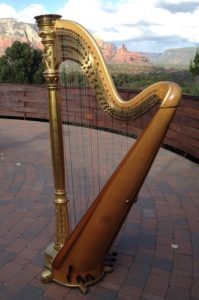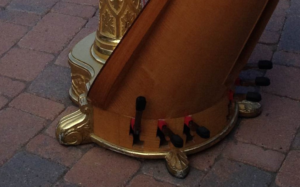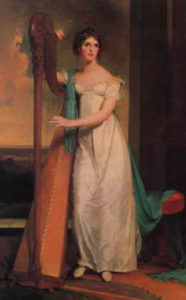
If you’re like me, the very thought of a harp creates a magical wistfulness inside. When I was twelve years old, I had an opportunity to take harp lessons, and something came alive inside me. Instantly, more than anything. I wanted–no, had–to learn to play. It’s been an ongoing love affair ever since.
Playing the harp takes years to master, and a great deal of time must be devoted to technique, not just learning to read music. It has been said that harp is the second most difficult instrument to learn to play. (Apparently bagpipes is the hardest.)
Back when I used to perform, many people come up to me after my performance and tell me that they’d never seen a harp up close before. I assume that’s a fairly common situation. So, I thought I’d give you a few basics of a classical pedal harp’s anatomy.
The “base” is the bottom part of the harp where it stands on the ground. The little claw looking things all around the base are called “feet.” When the harp is in use, it balances on the feet and rests against the inside of a harpist’s knees as well as lightly against the right shoulder. The long, thin part at the left of this picture is called the “column.” You probably could have guessed that, couldn’t you? The column is filled with long mechanical gears that help change the strings. The column exterior is usually intricately carved. Some of the more expensive harps, like Adrienne’s harp in the picture, are also gilded with gold leaf.

The photo on the right is a close up of the harp’s base where you can see the feet. You can also see the pedals (the black things that stick out). There are seven different pedals, one for every note in all the octaves. For example, one pedal controls all the harp’s C strings. Another pedal controls all of the D strings, and so forth. Moving the pedals into different positions can make each string either sharp, natural, or flat, as desired. When the moving the harp, the harpist can flip the feet up using a hinge so they rest closely against the harp’s body, cutting down on the likelihood of damage.
Until about a hundred years ago, harps had an eighth pedal which opened a panel in the back to allow access to changing out strings. Today’s modern harps have oblong holes that provides the same access. Strings must be fed through these access holes, through the holes in the soundboard, and wound around the little pegs in the picture below.

This photo of my harp to the left is a close up of the top, curving part of the harp, called the “neck,” which also shows the harp string pegs and all those little lever thingies which are called the “action.” These levers move when the harp pedals move, which shortens or lengthens the strings to change key depending on the position of the pedal. To tune, one tightens or loosens the strings, similar to tuning a guitar or violin, but a special tool is required–one cannot turn them with fingers.
You’ll also notice that some of the strings are red, some are black, and the rest are white. The red strings are C, the black are F. This allows the harpist to easily find the correct strings, although an advanced harpist pretty much knows where the strings are by the position of their arms and hands, but everyone needs an occasional guide, especially for performance. The strings are laid out like a piano (minus the black keys)–A, B, C, D, E, F, G. Then it repeats. My harp had six and a half octaves. The full-sized concert harps have seven. Smaller harps have fewer octaves.
The wide part of the harp that has all the scrollwork and painting is called the “soundboard.” Large soundboards usually have the biggest, richest tone. Tone can also be affected by the kind of wood used and age–the older ones have a gloriously rich tone.
A folk harp or lever harp is similar to a pedal harp–just smaller and has levers instead of pedals to change key. Folk harpist use their hands to change keys by flipping up a lever; classical harpists use their foot pedals.
Unlike some images, the harp is played with the body of the harp resting against the harpist’s right shoulder, opposite the column. Reportedly, Harpo Marx, who was a self-taught harpist, started playing the harp backwards–with the column, instead of the body of the harp, resting against his shoulder. When he realized his error, he changed his technique which, I am sure, helped him develop his skill. Many pictures show the harpist resting the body of the harp against her left shoulder which is not considered proper technique and indeed I would find very confusing because one would have to play the treble clef with the left hand instead of the right.
Harpists spend years perfecting the art of harp playing, and if done correctly, make it look easy by the graceful motion of their hands. Because of my great love for the harp, I mention a harp or harpist in all of my novels, and in most of my short stories and novellas.
Since music is such a part of my life, I decided to write a series of novels about musicians. The first one in the series is called Heart Strings which features a harpist and a violinist. In fact, one of my most beloved teachers was the great Phyllis Schlomovitz. I give a nod to her in my newest short novel when my heroine identifies her teacher Phillip Schlomovitz.
 Here is the backcover blurb for Heart Strings, book 1 in the Songs of the Heart Series, coming September 7, 2016, is now available for pre-order on Amazon.
Here is the backcover blurb for Heart Strings, book 1 in the Songs of the Heart Series, coming September 7, 2016, is now available for pre-order on Amazon.
Gently bred young ladies don’t run away from home to find employment, but when forced to choose between marrying a brutish oaf or becoming another man’s mistress, Susanna makes an unconventional decision. Following her passion for music, she flees to London with dreams of securing a position as a harpist. Becoming entangled with a handsome violinist who calls himself Kit, but who seems too aristocratic for a working-class musician, may be more problematic than sleeping in the streets.
Kit’s attention is captured by Susanna’s breath-taking talent, admirable grace, and winsome smiles…until a lawman exposes the new harpist as a runaway bride and a thief. With peril lurking in the shadows, Susanna’s imminent danger not only forces Kit to choose between his better judgment and his heart, but he must also embrace the life to which he swore he would never return.
Heart Strings, book 1 in the Songs of the Heart Series, coming September 7, 2016, now available for pre-order on Amazon.

You’re a harpist! How fascinating! Wish I’d known so that I could ask you all sorts of questions–although this blog gives most of the answers. How long does it take for your fingertips to get hardened to the plucking action? Or is it sort of the same as a guitar or any of the other stringed instruments that are plucked rather than sounded with a bow? But the music is so heavenly. Probably that’s why heaven and harps sort of go together–I’ll laugh if that turns out to be true!
Hi Beppie, thanks for stopping by! It takes a few weeks to get good callouses. Some songs are harder on the fingers than others. For example,the string in the lower register are wire so if there are a lot of notes there, the fingers need conditioning before performance.
Thanks for sharing about the harp. It’s an amazing instrument.